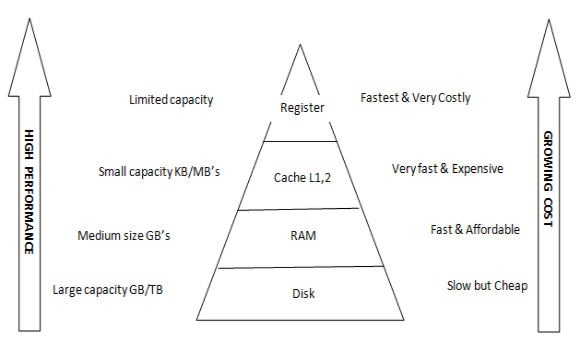
 Data Structure
Data Structure Networking
Networking RDBMS
RDBMS Operating System
Operating System Java
Java MS Excel
MS Excel iOS
iOS HTML
HTML CSS
CSS Android
Android Python
Python C Programming
C Programming C++
C++ C#
C# MongoDB
MongoDB MySQL
MySQL Javascript
Javascript PHP
PHPPhysics
Chemistry
Biology
Mathematics
English
Economics
Psychology
Social Studies
Fashion Studies
Legal Studies
- Selected Reading
- UPSC IAS Exams Notes
- Developer's Best Practices
- Questions and Answers
- Effective Resume Writing
- HR Interview Questions
- Computer Glossary
- Who is Who
What are the levels of memory in the Operating System?
Inside the computer system the memory hierarchy is arranged from fastest to the slowest as given below −
Registers
Caches memory
Main or Primary Memory
Secondary Memory
The memory hierarchy is depicted in the diagram given below −

Let us discuss about each memory in detail.
Register
Registers are very high speed memory, which is present inside the CPU. It is a temporary storage device that means it stores the data temporarily. Generally, they create a general purpose register file to store data. The register file capacity is 32 data words, and each register can be read or written from within a single clock cycle.
Cache Memory
The cache memory is the next level to the register. It is also a temporary storage device. It is placed logically in between the CPU registers and main memory.
The storage capacity of a cache is less when compared to main memory, but accessing time of cache is faster than main memory and slower than register, because some or all of it can reside on the same IC as the CPU.
The caches are essential components for the high performance computers.
Main or Primary Memory
It is an external memory present on the motherboard, that stores programs and data which is active in use. In primary memory, storage locations are addressed directly with the help of load and store instruction of the CPU.
Whereas an IC Technology is similar to the CPU register file that is used, but access is slower due to large capacity of main memory and at the same time it is separated from the CPU. Access time of five or more clock cycles is usual.
Secondary Memory
This memory is large in capacity but usually much slower when compared to other types of memories. It stores system programs, large data files. The capacity of the main memory is less when compared to secondary storage, and information is considered online, but is accessed indirectly through I/O programs that transfer information between main and secondary memory.
For example − The secondary memory is magnetic hard disks, pen drives and CD-ROMs etc. The storage capacity is typically in gigabytes and access time is measured in milliseconds.

